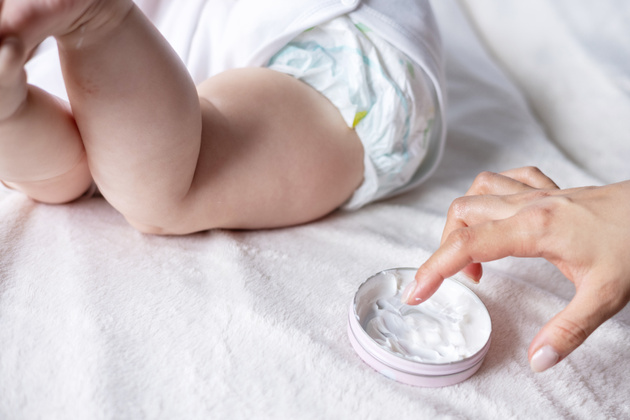How does diaper rash occur and how does it go away?
Diaper rash, one of the most common problems in newborns, is a skin disease that can be seen in all age groups. Rash, which develops due to excessive sweating, especially in hot weather, is more common in areas where skin friction is high, in overweight people, in those with sensitive skin, and in bedridden patients. Untreated diaper rash can cause open sores on the skin.

What is diaper rash?
Diaper rash, whose medical name is ammonia dermatitis, is the irritation of the skin, especially on the butt, outside of the genitals and around the groin, due to ammonia. Under normal conditions, urine contains urea, a derivative of ammonia. Urea does not irritate the skin. However, if the baby’s diaper is not changed frequently and urine remains on the skin for a long time, some bacteria convert urea into ammonia. Ammonia has a skin irritating effect. A type of fungus known as Candida albicans is responsible for converting urea into ammonia. This type of fungus uses urine and feces as nutrients. It creates the ideal environment for fungus to multiply in humid and hot regions.
How to understand diaper rash?
There is a thin layer of oil on the skin surface that helps protect the skin from external factors. Ammonia eliminates the protective effect of the oil layer, causing skin irritation. Diaper rash, which has characteristic effects such as a red wet appearance, stinging and burning on the skin in the groin, genital area and hip area, is usually seen in babies at the points where the diaper comes into contact with the skin. Irritations, which initially appear as slightly swollen redness, turn into water-filled blisters and small swellings over time and manifest themselves as painful burning. Rashes that are not taken without precautions become infected and the skin rash turns into a bright red color and expands. The skin disease, which is generally seen in babies aged 9-12 months, starts around the anus and causes rashes in the groin folds, scrotum and under the penis in boys, and on the labia majora in girls. The baby feels burning, itching and stinging in the areas where the blisters form, and may experience restlessness and crying spells.
What are the causes of diaper rash?
The causes of diaper rash in babies and adults are different.
Causes of diaper rash in babies:
- Cleaning agents and wet wipes used while cleaning the baby’s diaper may irritate the baby’s skin and cause diaper rash.
- Frequent defecation during diarrhea and urinary tract infections are the reasons that facilitate the formation of diaper rash.
- Changing the baby’s diaper late and not changing it frequently enough creates an ideal environment for bacteria to multiply and causes diaper rash.
- Switching from breast milk to formula and complementary foods causes changes in the pH of the baby’s urine and stool, which may cause diaper rash.
- Antibiotic treatments used for diseases, the baby’s teething period and diseases such as eczema can cause diaper rash.
- Some hereditary diseases and zinc deficiency are also factors that cause diaper rash in infancy.
Causes of diaper rash in adults:
- Fungal infections in people with weak immune systems are the most important cause of diaper rash, especially in the groin and vaginal area.
- Infections in the groin and vaginal area, such as viral ones, cause rashes in these areas and trigger the formation of diaper rash.
- Surgical procedures, bacteria and non-compliance with hygiene rules are among the most important causes of diaper rash in adults.
How to prevent diaper rash?
The most important rule to follow to prevent diaper rash is hygiene. The area where the diaper is attached must be kept clean, cool and dry. The baby’s diaper should be cleaned frequently and ventilated as often as possible. The baby’s skin should be allowed to come into contact with air for 10-15 minutes before the diaper is changed, and air should be allowed to pass into the diaper without tightening the waist area too much. Using diapers appropriate for the baby’s height and weight is another important factor that prevents diaper rash. When cleaning the baby’s lower area, a clean cotton pad should be dipped in warm water and used. Urine and feces should be purified with a perfume- and chemical-free disinfectant soap or just water. The baby’s lower area should be thoroughly dried and ventilated with a soft towel, and then the diaper should be tied. Clothing that allows the skin to breathe should be used and it should be ensured that the baby consumes enough water. Breastfeeding mothers’ attention to the use of medications such as antibiotics and the baby’s nutrition helps prevent diaper rash.
How to get rid of diaper rash?
Paying attention to the hygiene of the rash area and keeping it dry will help the rash to disappear within a few days. Lotions and creams containing zinc can be used on the irritated area. If there is no improvement in redness and swelling despite the measures taken within a few days, it is definitely beneficial to go to your family doctor or pediatrician. Creams and medications for diaper rash recommended by the pediatrician should be used regularly. Treatment of diaper rash in adults is done according to the cause. Use of hearsay medication for diaper rash, which usually develops due to fungal infection, may increase the degree of the disease.



